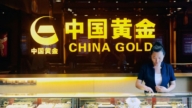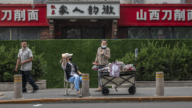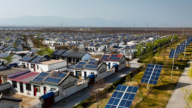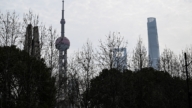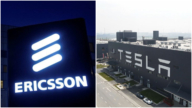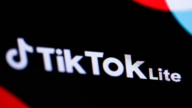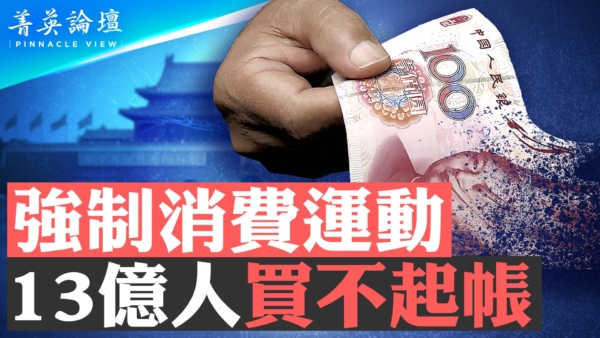【新唐人2014年10月01日讯】今年上半年,中国十大上市银行的不良贷款率创下近四年来新高,目前正在以两到三折,甚至更低的价格,出售给资产管理公司。作为买卖银行坏账主力军的四大资管公司,上半年利润增长高达30%以上,不过欠央行的再贷款却没有偿还。那么这四大资管公司赚的钱去了哪里?这些坏账最后又由谁买单?请看报导。
普华永道发布的最新数据显示,中国十大银行上半年的不良贷款余额和不良贷款率,“双双上升”。上半年不良贷款余额接近去年全年增幅,不良贷款率超过1%,银行坏账创下近四年新高。
另外,据银监会的数据,今年上半年,中国银行业金融机构不良贷款余额达6944亿,较去年末上升1023亿元,已经超过去年全年不良贷款的增加规模。
目前,银行正在大比例核销坏账,以两到三折,甚至一折或更低的价格,向资管公司出售资产包。据《人民网》报导,中信银行深圳分行在上海联合产权交易所挂牌一个资产包,含476笔不良债权、未偿本金余额16.69亿元的资产包,挂牌价只有2000万元,中间差额几十倍。
华融资产、东方资产、长城资产和信达资产,这四大资产管理公司是买卖银行坏账的主力军。1999年,中共决定将四大国有银行1.4万亿元的巨款坏账剥离,对口设立了这四大资管公司。
财政部作为唯一股东向每家公司注资100亿元,并担保四大资管公司从央行获得6041亿元再贷款;资管公司再向四大国有银行及国家开发银行发行8110亿元金融债券,以此按1:1的对价购买不良资产。也就是说,当时,这四大资管公司拿到1.4万亿不良资产时,不但没有付出一分钱,每家公司还从财政部拿到了100亿元。
中国金融智库研究员巩胜利:“国有的资产廉价给卖了,这当中的猫腻,它的结果,它悬殊的根源所在是很明白的一个问题,财政部或中央银行再没有很好的监管机制,这样卖下去我觉得可能比较吓人,长此以往亏的是国家,赚的肯定是资产管理公司。”
大陆《证券日报》评论说,今年上半年5581亿元上市银行不良贷款余额压力的背后,是资管公司的大丰收,它们赚得“盆满钵满”。
公开资料显示,四大资管公司今年上半年的利润增速都超过30%。其中长城资产达45%,东方资产达39%,华融资产达34.57%。而作为四大资管公司中唯一上市的信达资产,上半年收购853亿元不良债权资产,比去年同期上升100.2%。其中传统类不良资产增长率达240.0%,上半年净利润同比增长30.3%。
虽然这些资管公司靠超低价格吸收不良资产大发横财,大陆《和讯》财经网专栏作家周彦武却指出,四大资管公司目前仍然欠央行约1万亿,欠四大国有银行8200亿,原购入的1.4万亿不良资产也只有20%现金回收。
周彦武认为,无论这些欠款进入“共管账户”,还是债券延期、停息挂账,都不过是在国家资产负债表的不同科目下“左兜换右兜”。
债务就是债务,企业核销可以靠利润,而财政核销要靠纳税,央行核销只能靠印钱,那么银行坏账的最后由谁买单?
据披露,这些资产管理公司大多由中共太子党经营。2011年,前中共党魁江泽民孙子经营的博裕资本,投资5,000万美元入股信达资产。2005年初,中共审计署披露,四家资产管理公司,被查出各类违规和管理不规范问题资金700多亿元,发现案件线索38件、涉案资金67亿元。
采访编辑/刘惠 后制/陈建铭
China Bargained Away Bad Loans to Its
Asset Management Companies.
In the first half of 2014, China’s ten major listed banks saw
a record high rate in non-performing loan ratios.
They are selling those loans at 20 to 30 percent of the
original prices, or even lower, to asset management firms.
As a result, China’s four asset management firms reported
that their half-year profit has grown by over 30 percent.
However, they have not paid back loans from the
Central Bank. So, where do their profits go?
Who will finally pay the bill for those bad loans?
Let’s look at the report below.
According to the latest statistics by PWC, China’s ten major
banks had an increase in both total balance and ratios of
non-performing loans in the first half of 2014.
The total balance of non-performing loans has almost
reached the figure from the whole of 2013.
The ratio of non-performing loans also exceeds 1 percent,
a record high in the past 4 years.
The Banking Regulatory Commission also announced that,
China’s financial industry had a total balance of 694.4 billion
Yuan ($113 B) in bad loans by the first half of 2014.
The figure increased by 102.3 billion Yuan ($16.7 B)
compared to the end of 2013.
The increment itself has exceeded that from the
whole of 2013.
China’s banks are making big moves to eliminate bad loans.
They packaged those loans and are selling them to asset
management firms at hugely reduced prices.
People’s Daily website reported that China Citic Bank’s
Shenzhen branch is selling an asset package at Shanghai
United Assets and Equity Exchange (SUAEE).
The package includes creditor rights of 476 bad loans,
which total 1.67 billion Yuan ($270 M) of unpaid capital.
The package is sold at only 20 million Yuan ($3.3 M),
almost one eightieth of its original value.
Huarong, Orient, Great Wall and Cinda are the four asset
management companies that take most bad loans in China.
Back in 1999, the Chinese Communist Party (CCP) decided to
eliminate 1.4 trillion Yuan ($228 B) of bad loans from its
big four state-owned banks, and so established these
four asset management firms.
As the only shareholder, the CCP’s Ministry of Finance
invested 10 billion Yuan ($1.63 B) into each company,
and offered warrants for them to obtain refinance of
604.1 billion Yuan ($98 B) from the Central Banks.
Then the four companies sold financial bonds of 811 billion
Yuan ($132 B) to the big four state-owned banks and the
China Development Bank. Bad assets were handed over to
those four companies with these two trades.
It is clear that the asset management firms did not spend
a single cent in“purchasing” the huge amount of bad loans.
In total they came to 1.4 trillion Yuan.
In addition, each company was given 10 billion Yuan
by the Ministry of Finance.
Gong Shengli,“dirty tricks of bargaining away state-owned
assets and the consequences are clearly big problems.
Neither the CCP’s Ministry of Finance nor the Central Bank
has good supervision systems.
The result can be horrifying if things continue.
From a long-term point of view, the state will lose a lot
while asset management firms will make huge profits.”
China’s Securities Daily said, listed banks were pressured
by bad loans totaling 558.1 billion Yuan.
However asset managers have made huge profits from that.
Open data shows all four asset management firms saw
more than 30 percent increase in profit.
The figures are: Great Wall 45 percent; Orient 39 percent;
Huarong 34.57 percent.
As the only listed company among the four, Cinda“purchased”
bad loans of 85.3 billion Yuan ($13.9 B) in the first half of 2014.
This was an increase of 100.2 percent from last year.
The rate of increase for traditional bad assets is 240 percent.
Cinda makes 30.3 percent more profit compared to
the same period of 2013.
Cinda and others are making huge profit by getting bargains.
However, Zhou Yanwu, a column writer of Hexun Finance,
commented that those four companies still owed about
1 trillion Yuan ($160 B) to the Central bank, and 820 billion
Yuan ($133.6 B) to the big four state-owned banks.
In addition, they have only retrieved 20 percent of
the 1.4-trillion-Yuan package in cash.
Zhou Yanwu said, trading bad loans, extending bonds,
suspending debts and other tricks are nothing more
than“moving state debts from one pocket to another”.
To clear debts, companies need profits and financial
departments need taxes.
The Central Bank has to print money. So in the end, who will
pay the bill for those bad loans in the banks?
Sources said, asset management companies are mostly
controlled by the CCP princelings.
In 2011, Boyu Capital which is run by Jiang Zemin’s
grandson, invested 50 million dollars in Cinda.
In early 2005, the CCP’s auditing administration revealed
that the four asset management firms were illegally using
or managing capitals totaling over 70 billion Yuan ($11.4 B).
Thirty-eight case clues were also found, which involved
a total of 6.7 billion Yuan ($1.1 B) in capital use.
Interview & edit/LiuHui Post-Production/Chen Jianming


